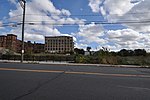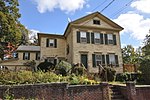St. Stanislaus Kostka Parish, Waterbury
1913 establishments in Connecticut20th-century Roman Catholic church buildings in the United StatesBuildings and structures in Waterbury, ConnecticutChurches in New Haven County, ConnecticutPolish-American Roman Catholic parishes in Connecticut ... and 3 more
Roman Catholic churches completed in 1926Roman Catholic parishes of Archdiocese of HartfordUnited States Roman Catholic church stubs

St. Stanislaus Kostka Parish is a former parish in Waterbury, Connecticut, United States, originally designated for Polish immigrants. Founded on January 30, 1913. It is one of the Polish-American Roman Catholic parishes in New England in the Archdiocese of Hartford. In 2017, the parish was merged with Saint Anne Church in the south end to form All Saints Parish. The building was closed for regularly scheduled worship, and subsequently sold to a Pentecostal church.
Excerpt from the Wikipedia article St. Stanislaus Kostka Parish, Waterbury (License: CC BY-SA 3.0, Authors, Images).St. Stanislaus Kostka Parish, Waterbury
East Farm Street, Waterbury
Geographical coordinates (GPS) Address Nearby Places Show on map
Geographical coordinates (GPS)
| Latitude | Longitude |
|---|---|
| N 41.562444444444 ° | E -73.02825 ° |
Address
St. Stanislaus Kostka Church
East Farm Street 86
06704 Waterbury
United States
Open on Google Maps








